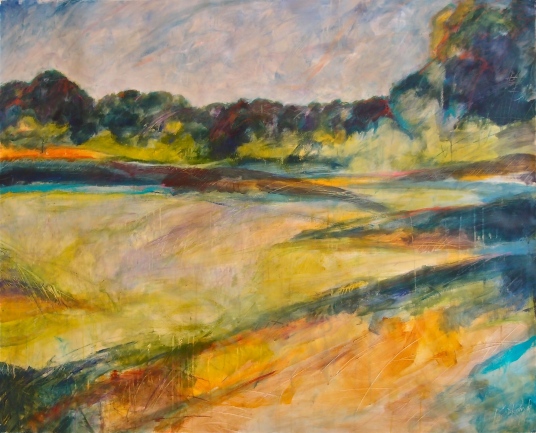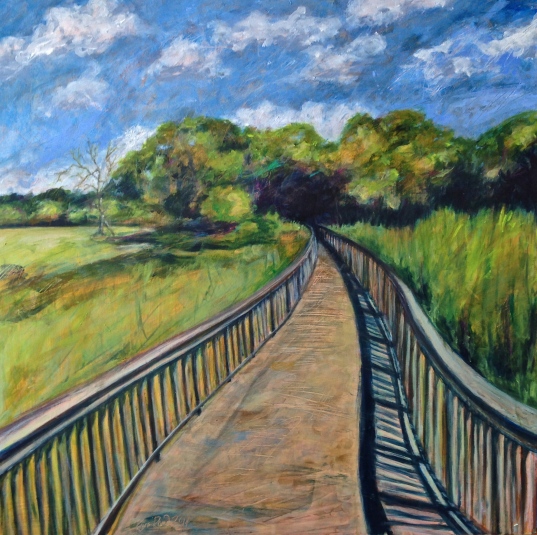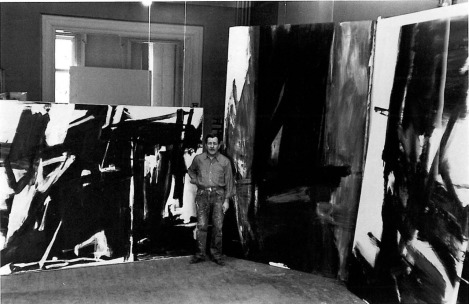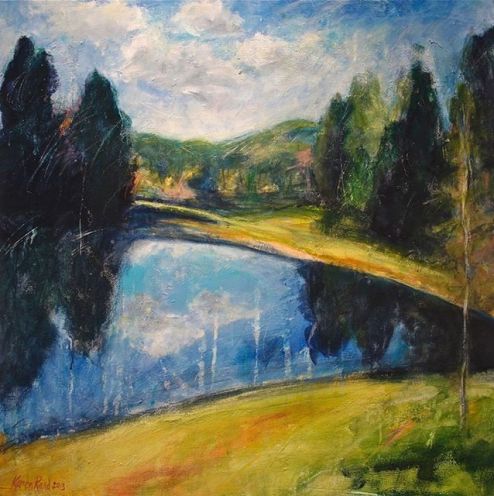Painting a piece of a painting…? I’ve played with this idea in the past (not very successfully)– to isolate a small section of a painting, and reference it to make a large painting. If only I could magnify the immediacy and verve that live in those sexy little sections that were produced through spontaneity and intuitive mark-making, and create BIG paintings echoing those same qualities. Sounds easy. Ha.
So my last post showed the large piece I recently finished— “New Territory”.
“New Territory. 53×65”. mixed media on Fabriano paper. ©2014 Karen Rand Anderson
What I didn’t say about it is that it’s actually referenced from a very small detail from another painting, “Shadow Walk”, 36×36”, mixed media on wood panel. See the loose reference? This detail is about 4×6″. (I left out the dead tree in the 53×65″painting.)
Here’s the quick journal sketch: 
And here’s the original painting:
Shadow Walk, 36×36″. mixed media on wood panel. ©2014 Karen Rand Anderson
I still like the detail best.
Abstract expressionist Franz Kline was able to maintain that freshness from small sketches to gargantuan canvases. He loved the quality of the mark-making in his small quick brush sketches, and in 1948 when his buddy Willem de Kooning turned him on to the Bell-Opticon opaque projector, he discovered he could project those small energetic strokes as enlarged abstract gestures. He grabbed a big brush, some black house paint, and used the projected images as templates for some very big paintings, which became huge calligraphic statements on the canvas.
When Kline first projected one of his small ink sketches onto the wall, this is what he described:
“A four by five inch black drawing of a rocking chair…loomed in gigantic black strokes which eradicated any image, the strokes expanding as entities in themselves, unrelated to any entity but that of their own existence.”
Sounds like abstract expressionism in a nutshell.
Franz Kline (American, 1910-1962). Untitled II, ca. 1952. Ink and oil on cut-and-pasted telephone-book pages on paper on board. 11 x 9 in. (28.1 x 23 cm). © 2010 The Franz Kline Estate / Artists Rights Society (ARS), New York
Here’s a short, jazzy little video from the MoMA about Kline’s painting process.
Keep in mind that the bigger you go, the more you spend— time, materials, energy. Bigger brushes=expensive; bigger canvas or panel= way expensive; more paint (oil or acrylic) = way, way more expensive. Klein used black enamel house paint because he could get it inexpensively, and loved the workability of it. [Oh well, I’m a coloroholic, I’ll admit it. Also I use water-based materials. No more toxic stuff in my studio] So, big for me is say, 60 or 70″. Big for Kline was, well, REALLY big.
While Kline sometimes used a projector to magnify his images, I take small digital detail pics with my iPhone and then make awkward sketches of them in my art journal before attempting to translate the image into a larger scale. I wonder. Should I find a projector?
detail, from “Vermont Reflections” On it’s way to becoming a big painting…. maybe.
“Vermont Reflections” 24×24″. mixed media on canvas. ©2014 Karen Rand Anderson








I found this via search of Franz Kline and you zoomed in on exactly what I love about his work. I also use my iPhone to take close ups and I have been trying to recreate them. TY for sharing!
LikeLike
Thanks for your message, Shelley. I let my blog languish in 2016… maybe 2017 will re-inspire me. Glad you found one of my old posts worthwhile! Best luck with your work, and Happy New Year!
LikeLike
Thanks for your message, Shelley. I let my blog languish in 2016… maybe 2017 will re-inspire me. Glad you found one of my old posts worthwhile! Best luck with your work, and Happy New Year!
LikeLike
Pingback: Sunday Morning Snooze – Part 2 | Boring Broad's Adventures
I have my two monitors set to display two different images from my “Paintings” folder, changing every 30 minutes. Because I have them set to “Fill” they’re perforce cropped depending on the aspect ratio of the painting. I’ve been enjoying both the random selection and the random section; indeed I see lots of new possibilities. Not that I have that much time!
LikeLiked by 1 person
instead of a projector, start with accuview, an iPhone/ipad app that allows you to crop & grid any digital image. I love it!
LikeLiked by 1 person
Thanks Marion.. I wasn’t really planning on a projector, but I’ll definitely look into the app!
LikeLike
You included so much good information – how you approach painting, how to make landscape with abstract marks, plus art history tutorial on Franz Kline
LikeLiked by 1 person
🙂 thanks Nancy.. I’m having fun!
LikeLike